8 minute read • published in partnership with Albright IP
Insight: When to protect your product and start manufacturing
Do you have an innovative new product that has been undergoing product manufacturing and development, and that you are now excited to share with the world? Perhaps you have already produced a prototype and are eager to start manufacturing your product on a large scale. But have you thought about protecting your product and what options are available to you to do so? Adrian Hocking from Albright IP explains.
Intellectual property (IP) rights are intended to cover this form of protection and include filing a patent application to protect the inventive concept of the product, as well as a design application to protect the visual appearance of the product. The inventive concept of the product outlines the ways in which the product differs technically to similar products already available on the market today.
This article is split into two parts: Part 1 discusses patent applications and Part 2 discusses design applications. Both articles aim to identify:
• How to avoid disclosing your invention to the public and why it is important to avoid doing this.
• When to consider IP in regard to your invention.
• When to file a patent and a design application, and which order the applications should be filed.
• The options available if you change the underlying idea for your invention.
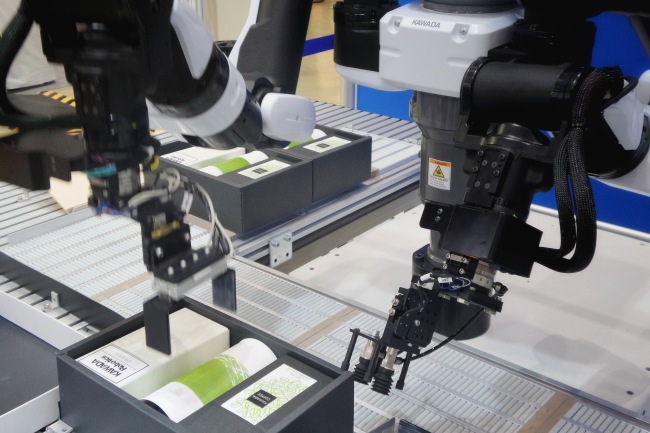
Albright IP recommends that you first file a patent application for your new product before you begin product manufacturing / Picture: possessed photography
So, when do I start the product manufacturing process? The answer to that question first requires a basic understanding of patent protection, because the two things (product manufacture and patent protection) are intrinsically interlinked.
Part 1 – Patent Applications
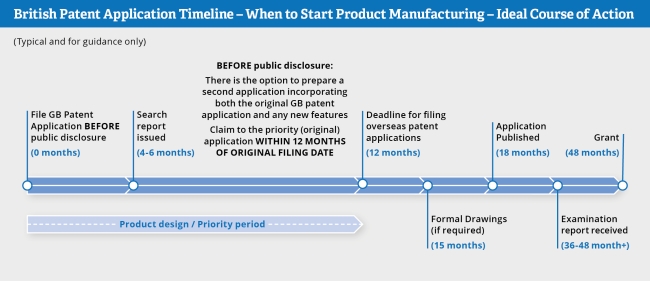
Typical timeline for a Patent Application in the UK from start to grant / Graphic: Albright IP
How to Avoid Disclosing Your Invention Before Filing a Patent Application
An invention can be disclosed in a number of ways, from purposely advertising the invention online or even through unintentionally posting about the invention on your social media.
The easy answer here is to avoid disclosing your invention at all until your intellectual property rights (a patent application and/or a design registration) are safely filed. The general rule of thumb which will always keep you safe is to keep the invention under wraps, and fully launch the product only after applying for legal protection.
Be aware that a design registration (also called a ‘design patent’ in the USA) protects the exterior ‘look’ of a product. It does not protect the function of the product. To protect the clever function or the technical improvement, irrespective of how the product actually looks to the consumer, then that is what a patent is for. It is also worth bearing in mind that a design registration and a patent application work together, and it is often the case that both will be required for a new and innovative product.
But, what happens if I file a design registration to the ‘look’ of my product, before I then file a patent application? It is critical to remember that a design application will often publish very quickly. If your invention or development is disclosed by filing the design application first, it is highly likely that you will not be able to achieve a granted patent following that disclosure. Therefore, an important consideration when one files a design application is that you could be disclosing the invention before a patent application is filed. This example is outlined in Figure 1.
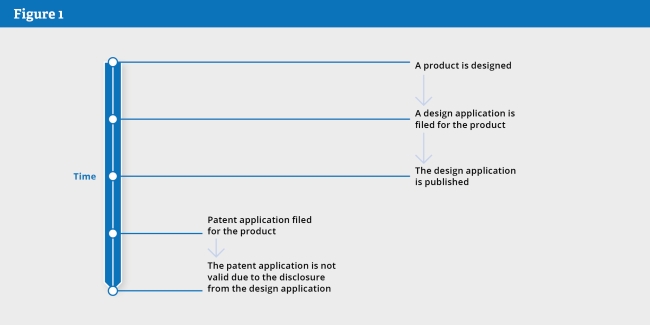
Graphic: Albright IP
Although a marketing team may want to gauge customer interest by advertising the product, it is critical that this is avoided prior to filing your patent rights. As mentioned above, although in the UK a design application allows disclosure up to 12 months before filing (but remember this is not the same in all territories around the world!), disclosure before filing a patent application is not as lenient and will invalidate your rights. Just to reiterate the point above, the safest rule is to file first before any disclosure.
Once a patent application is filed, the invention can be disclosed. The patent application will automatically become available to the public, and therefore publicly disclosed at 18 months after filing the application, unless it is a requirement to remain a secret.
If you need to disclose the invention, for example you need a product designer’s opinion to see whether it is possible to produce the invention, or for financial reasons, a non-disclosure agreement (NDA) should be used. This is a contract binding the parties to confidence. You can be assured that all regulated patent attorney firms are required to keep the information about your invention confidential. Therefore, an NDA is not required with a qualified, chartered and regulated patent attorney.
Our advice for filing a patent application to avoid any difficulties is simple: ensure that you have a concrete idea of what the final product will be and then file the patent application as soon as possible; ideally before the product manufacturing process. Once the patent application is filed, then the filing of a design application can be considered in preparation for the launch of the final product.
Why Should IP Protection be Considered Early?
Figure 2 below outlines an example of a scenario if IP protection is not considered early. For clarity purposes, let’s say that you, the reader, are Company A and you have invented product X. Company B has the same brainwave as you and immediately files a patent application for product X.
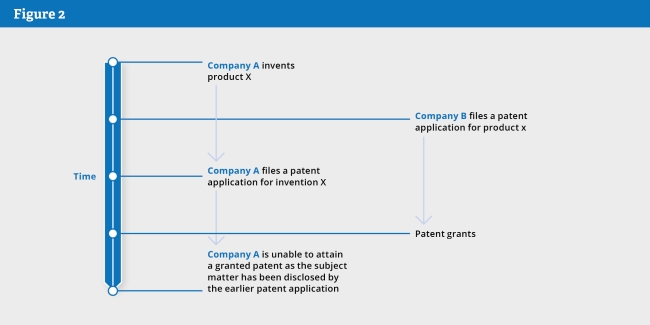
Why file a patent application early / Graphic: Albright IP
If applying for a patent application is left too long, then there is no guarantee that the inventive concept will be protected if another company files a patent application covering the same subject matter. The inventive subject matter to be protected is outlined in the claims of the patent application.
When a patent application is filed, the invention benefits from a ‘patent pending’ status. Having a ‘patent pending’ status provides the application with ‘provisional protection’. This so-called ‘provisional protection’ period is active between the publication of the patent application up until the grant of the patent application. If an infringing act is undertaken by another party in the ‘provisional protection’ period, the applicant may be able to collect retrospective damages.
Even if the original company, in this case Company A, invented product X, it would be a huge risk to continue making, disposing of, using, importing or keeping the product as these would constitute infringing acts. See our section on patent infringement. Therefore, the importance of filing a patent application early is clear.
Before a patent application is filed, or product manufacturing has begun, it is advised that due diligence is carried out. This involves conducting a search to check if any IP rights already exist and, therefore, if there is a risk of infringement before the launch of your product.
In Figure 3, we are using the examples of Company A and Company B once more. Again, let’s imagine that Company A is you, the reader.
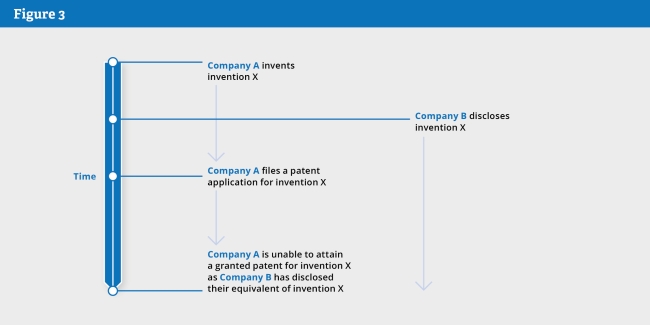
The disclosure pitfall / Graphic: Albright IP
As explored in Figure 3, potential disclosure of the invention is another important aspect to consider. Company A has dreamt up an invention X, but it just so happens that another party, Company B, also has the same idea and puts it onto their weekly newsletter which is sent to their database of 500 customers. Even if Company B doesn’t file a patent application, they have still publicly disclosed the invention to their customer database via their newsletter. While Company A could file a patent application, the prior disclosure by Company B would prevent the application from being granted even if Company A came up with the invention in the first place.
These examples are why considering IP protection early in the development process is a priority. Doing so could save you valuable time and money over the longer run.
What if You Want to Change the Product After Filing?
Let’s assume that the suggestion to file an initial patent application early on to protect the broad concept prior to serious product design, prototyping and manufacture has been undertaken. What if you or the product design team comes up with further features for the invention during the development and testing phases?
It is important to note that there is a 12-month period following the first filing of a patent application in which you can file a second or an updated patent application. The second patent application can claim the same filing date as the first application for the original material, but the second application can incorporate further or new features of the invention, provided those further features have not already been made public.
The first patent application includes:
• A broad outline of your invention.
• Specifics of the current features, including caveats which may cover some versions of the product which may be manufactured by you (or your competitors) in the future.
During the next 12 months after filing the first patent application (assuming this is at the UK Intellectual Property Office), a search report will be issued for the first application. This is a report with basic analytics which outlines any documents or products that could be similar to your own invention. The search report can provide a potential direction for how to develop the invention in the first application further.
Alternatively, if you want to change your product slightly after the first application, you can decide to file a further updated patent application. This second application builds on the claims and description of the first application and can claim the filing date of the first application, as long as a second application is filed within 12 months of the first application. Any new material in common to both applications will be backdated to the filing date of the first application. However, new features cannot be backdated.
If, however, the inventive concept of the product has deviated significantly from your original application and the aspects of the invention are not supported by the original application, then a new patent application will need to be drafted directed to the new concept.
If you are still figuring out the main concept of your product, then it is best to have a fully formed idea, than something incredibly broad, i.e. if you are not completely sure what the product is trying to achieve. At this point, we will not be able to fully visualise the invention, if the concept itself is vague and drafting a patent application may be difficult.
Therefore, before manufacturing of the invention is considered, you must envisage what the final product will be before you can effectively think about the IP side of things. This will prevent you putting substantial amounts of time and money into the manufacture of products that, in the end, you might not be able to sell.
Summary
In this Part 1 article we have concluded the following points:
• Once you have a finalised product, we strongly recommend that you first file a patent application covering the inventive aspects or technical improvements before you disclose the invention to the public or begin product manufacture.
• IP should be considered before starting large-scale production of your invention, as this will prevent wasting large amounts of money on an invention that may already be disclosed.
• If you decide to change your product after filing a first application, there is an option to file a second application covering the new aspects of the invention, provided the second application is filed within 12 months of the first application.
